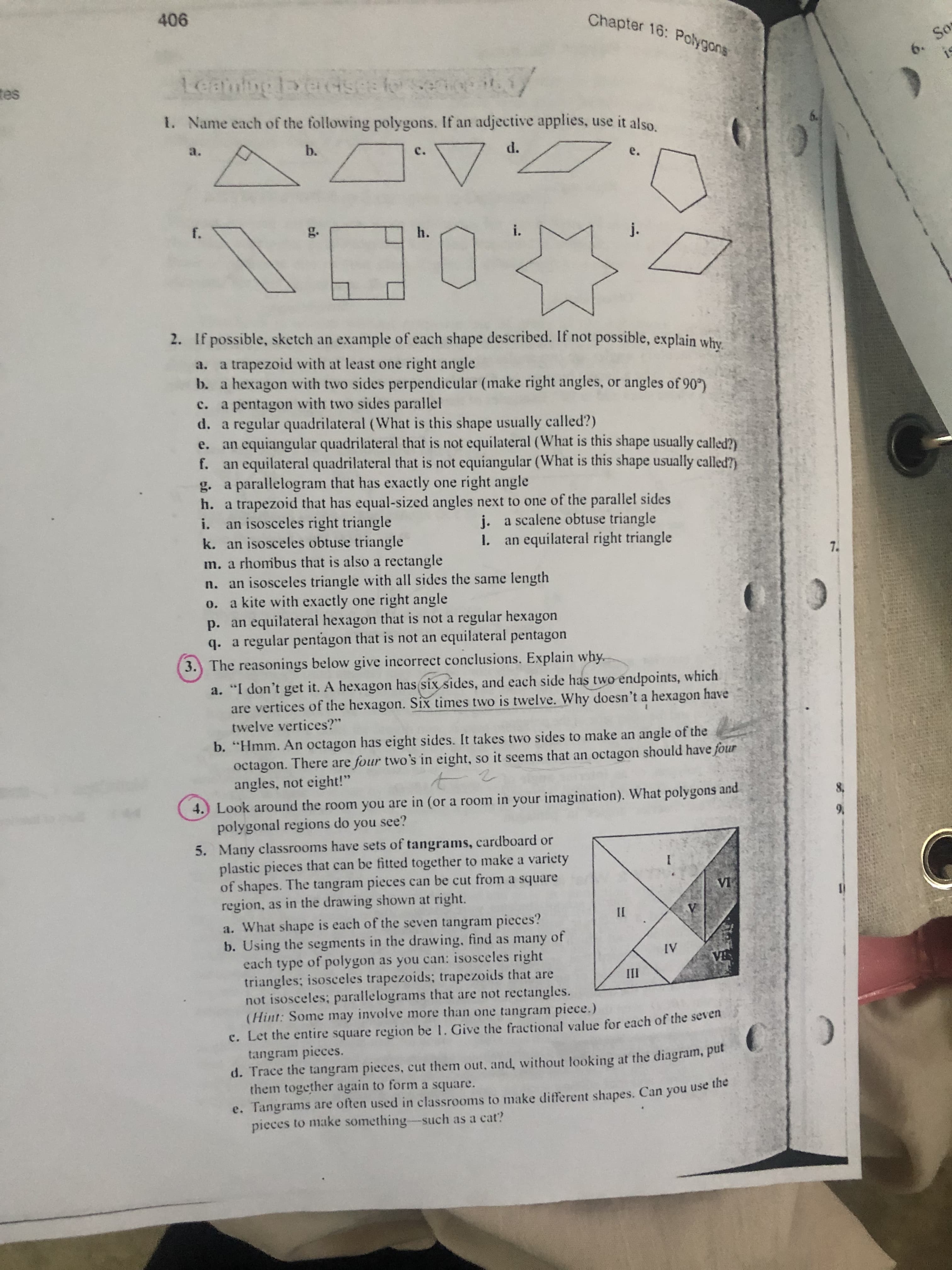406 Chapter 16: Polygons So 6. 19 1eatibeloedsce es 1. Name each of the following polygons. If an adjective applies, use it also. a. b. d. c. e. f. go h. i. j. 2. If possible, sketch an example of each shape described. If not possible, explain why a. a trapezoid with at least one b. a hexagon with two sides perpendicular (make right angles, or angles of 90) a pentagon with two sides parallel d. a right angle C. regular quadrilateral (What is this shape usually called?) equiangular quadrilateral that is not equilateral (What is this shape usually called?) equilateral quadrilateral that is not equiangular (What is this shape usually called?) g. a parallelogram that has exactly h. a trapezoid that has equal-sized angles next to one of the parallel sides i. an isosceles right triangle k. an isosceles obtuse triangle m. a rhombus that is also a rectangle n. an isosceles triangle with all sides the same length 0. a kite with exactly one right angle p. an equilateral hexagon that is not a regular hexagon q. a regular pentagon that is not an equilateral pentagon 3. The reasonings below give incorrect conclusions. Explain why e. an f. an right angle one j. a scalene obtuse triangle I. an equilateral right triangle 7 a. "I don't get it. A hexagon has six sides, and each side has two endpoints, which are vertices of the hexagon. Six times two is twelve. Why doesn't a hexagon have twelve vertices?" b. "Hmm. An octagon has eight sides. It takes two sides to make an angle of the octagon. There are four two's in eight, so it seems that an octagon should have four angles, not eight!" 4.) Look around the room you are in (or a room in your imagination). What polygons and polygonal regions do you see? 8. 9 5. Many classrooms have sets of tangrams, cardboard or plastic pieces that can be fitted together to make a variety of shapes. The tangram pieces can be cut from a square region, as in the drawing shown at right. a. What shape is each of the seven tangram pieces? b. Using the segments in the drawing, find as many of each type of polygon as you can: isosceles right triangles; isosceles trapezoids; trapezoids that are not isosceles; parallelograms that are not rectangles. (Hint: Some may involve more than one tangram piece.) c. Let the entire square region be 1. Give the fractional value for each of the seven tangram pieces. d. Trace the tangram pieces, cut them out, and, without looking at the diagram, pu them together again to form a square. VI II IV VE III e. Tangrams are often used in classrooms to make different shapes. Can you use the pieces to make something-such as a cat?
Addition Rule of Probability
It simply refers to the likelihood of an event taking place whenever the occurrence of an event is uncertain. The probability of a single event can be calculated by dividing the number of successful trials of that event by the total number of trials.
Expected Value
When a large number of trials are performed for any random variable ‘X’, the predicted result is most likely the mean of all the outcomes for the random variable and it is known as expected value also known as expectation. The expected value, also known as the expectation, is denoted by: E(X).
Probability Distributions
Understanding probability is necessary to know the probability distributions. In statistics, probability is how the uncertainty of an event is measured. This event can be anything. The most common examples include tossing a coin, rolling a die, or choosing a card. Each of these events has multiple possibilities. Every such possibility is measured with the help of probability. To be more precise, the probability is used for calculating the occurrence of events that may or may not happen. Probability does not give sure results. Unless the probability of any event is 1, the different outcomes may or may not happen in real life, regardless of how less or how more their probability is.
Basic Probability
The simple definition of probability it is a chance of the occurrence of an event. It is defined in numerical form and the probability value is between 0 to 1. The probability value 0 indicates that there is no chance of that event occurring and the probability value 1 indicates that the event will occur. Sum of the probability value must be 1. The probability value is never a negative number. If it happens, then recheck the calculation.
For problem 5 a through e, which is the easiest way to find the answers ?

Trending now
This is a popular solution!
Step by step
Solved in 4 steps with 3 images







